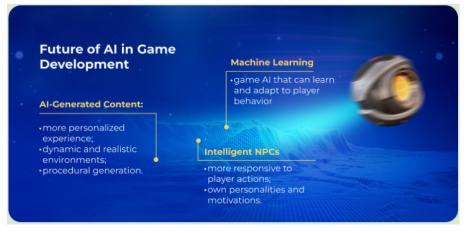Game developers are always looking for ways to improve upon the gaming experience for players. The goal is to make challenging, exciting and most importantly fun games for the player. With the current growth of advancements in technology there are now more ways than ever to achieve the desired goal.
In this third and final part in a series exclusively written for PG.biz, iLogos Game Studios founder Alexander Goldybin explores AI assisted game design, its limitations and the future of AI in games development. Get up to speed with part one and two and enjoy part three below.
Understanding AI-Assisted Game Design
Before we dive into the benefits of using AI in game design, let's first understand what AI-assisted game design is and how it works.
AI-assisted game design involves using algorithms and machine learning to analyse various aspects of a game, such as player behaviour, game mechanics, and level design. This analysis helps game developers identify areas needing improvement and make the necessary changes to enhance the gaming experience.
Benefits of AI-Assisted Game Design
Now that we understand what AI-assisted game design is, let's explore the benefits of using AI in game design.
1. Personalisation: One of the significant benefits of using AI in game design is personalisation. With AI, game developers can analyse players' behaviour and preferences, such as their playstyle, favourite game mechanics, and preferred difficulty level. This information can then be used to create a personalised gaming experience for the player, making the game more engaging and enjoyable.
2. Time-Saving: Game development is a time-consuming process requiring much effort and resources. Using AI, game developers can automate many tasks involved in game design, such as level creation, character design, and sound effects. This automation saves time and allows developers to focus on other critical aspects of game development, such as storyboarding and game mechanics.
3. Improved Game Mechanics: AI can analyse game mechanics and identify areas that need improvement. For example, if a particular game mechanic is causing frustration for the player, AI can identify it and suggest ways to modify it to enhance the player's experience.
Challenges of AI-Assisted Game Design
While AI-assisted game design has many benefits, it also comes with its set of challenges. Let's take a look at some of these challenges:
1. Lack of Human Creativity: One of the significant challenges of AI-assisted game design is the lack of human creativity. AI can analyse and make decisions based on data but cannot create something entirely new from scratch. Game development requires a certain level of creativity and imagination, which may be challenging for AI to replicate.
2. Data Bias: AI is only as good as the data it is trained on. If the data used to train the AI is biased in some way, the AI will also be biased. This can result in a less diverse and inclusive gaming experience for players.
3. Complexity: The use of AI in game design can be complex and require a high level of expertise. Not all game developers have the necessary skills and knowledge to use AI effectively, which can limit its adoption in the gaming industry.
AI-based game testing has become increasingly popular in recent years, allowing developers to automate the testing process and catch bugs and glitches more efficiently.Alexander Goldybin
AI-Based Game Testing
As game developers, we all know the importance of testing our games before releasing them to the public. However, manual testing can be time-consuming, expensive, and prone to human error. That's where artificial intelligence comes in. AI-based game testing has become increasingly popular in recent years, allowing developers to automate the testing process and catch bugs and glitches more efficiently. In this chapter, we'll explore the benefits of AI-based game testing and how it can improve the quality of your games.
What is AI-Based Game Testing?
AI-based game testing involves using machine learning algorithms and other forms of artificial intelligence to test games automatically. This can include everything from detecting bugs and glitches to analysing player behaviour and identifying areas for improvement in game design. AI can also simulate real-world scenarios, such as network latency and device performance, to ensure that games perform well in all situations.
The Benefits of AI-Based Game Testing
There are many benefits to using AI-based game testing. First and foremost, it can save developers time and money by automating the testing process. This allows developers to catch bugs and glitches more efficiently and focus on other aspects of game development.
AI-based game testing can also improve the quality of games by identifying areas for improvement in game design. For example, AI can analyse user data to determine which features are most popular or which levels are the most challenging. This information can be used to make informed decisions about game design and improve the overall player experience.
Finally, AI-based game testing can help ensure that games perform well in all situations. This includes simulating real-world scenarios, such as network latency and device performance, to ensure that games work well on all devices and in all situations. This can help prevent issues like crashes and freezes, which can frustrate players and harm the game's reputation.
Challenges and Limitations of AI-Based Game Testing
AI-based testing requires significant expertise and resources to implement effectively. This can be a barrier for smaller development teams or indie developers.
Another challenge is that AI-based testing can only identify issues it has been programmed to detect. This means that it may not catch all types of bugs or glitches, especially those that are more complex or unusual. Additionally, AI-based testing can sometimes generate false positives or false negatives, which can lead to incorrect conclusions about the quality of the game.
Finally, AI-based testing cannot replace manual testing entirely. While it can save developers time and effort, human testers still need to ensure that games are enjoyable and engaging for players.

Limitations of AI
One of the biggest challenges in implementing AI in game development is the limitations of AI itself. While AI can provide more realistic gameplay and challenge opponents, it is not perfect. AI can only do what it has been programmed to do, and it can sometimes be predictable.
Additionally, AI can be resource-intensive, requiring a lot of processing power and memory to run. This can make it difficult to implement AI in games that are already pushing the limits of the hardware they are running on. As game developers, we need to find ways to balance the benefits of AI with its limitations to create a truly engaging gaming experience.
Data Collection and Analysis
Another challenge in implementing AI in game development is data collection and analysis. AI requires a lot of data to work effectively, and this data needs to be collected and analysed before it can be used. This can be a time-consuming and resource-intensive process.
Summary: Future of AI in Game Development

AI has already made significant strides in the gaming world. From creating smarter enemy AI to generating realistic environments, AI has helped us create more immersive and engaging games. However, the future of AI in game development goes far beyond what we have seen so far. With the continued growth of AI technology, we can expect to see even more innovative and exciting games in the future.
One can expect a decrease in production costs due to the faster capabilities of generative AI. However, legal issues concerning content ownership remain unresolved.Alexander Goldybin
"The future is evident; AI can be used in various scenarios. Currently, generative AI provides the maximum number of opportunities by greatly simplifying and speeding up many aspects. Its applications include a game design for text development, character creation, dialogues, and generating NPC responses. Additionally, it can assist in writing any supplementary materials using LLM. AI can still be utilised for various types of bots, such as behaviour trees and their subcategories and other forms like reinforcement learning. Genetic algorithms are also periodically employed. However, these AI methods are used in a more fragmented and less widespread manner. Finally, generative AI can be applied to create art assets, leading to a significant reduction in content production time. Consequently, one can expect a decrease in production costs due to the faster capabilities of generative AI. However, legal issues concerning content ownership remain unresolved”. Alexander Goldybin, Founder and Chairman of the Board iLogos Game Studios
Edited by Paige Cook























